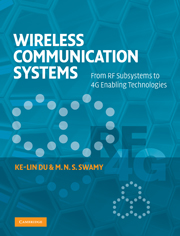Book contents
- Frontmatter
- Contents
- Preface
- Abbreviations
- 1 Introduction
- 2 An overview of wireless communications
- 3 Channel and propagation
- 4 Cellular and multiple-user systems
- 5 Diversity
- 6 Channel estimation and equalization
- 7 Modulation and detection
- 8 Spread spectrum communications
- 9 Orthogonal frequency division multiplexing
- 10 Antennas
- 11 RF and microwave subsystems
- 12 A/D and D/A conversions
- 13 Signals and signal processing
- 14 Fundamentals of information theory
- 15 Channel coding
- 16 Source coding I: speech and audio coding
- 17 Source coding II: image and video coding
- 18 Multiple antennas: smart antenna systems
- 19 Multiple antennas: MIMO systems
- 20 Ultra wideband communications
- 21 Cognitive radios
- 22 Wireless ad hoc and sensor networks
- Appendix A The Q-function
- Appendix B Wirtinger calculus
- Index
Preface
Published online by Cambridge University Press: 05 June 2012
- Frontmatter
- Contents
- Preface
- Abbreviations
- 1 Introduction
- 2 An overview of wireless communications
- 3 Channel and propagation
- 4 Cellular and multiple-user systems
- 5 Diversity
- 6 Channel estimation and equalization
- 7 Modulation and detection
- 8 Spread spectrum communications
- 9 Orthogonal frequency division multiplexing
- 10 Antennas
- 11 RF and microwave subsystems
- 12 A/D and D/A conversions
- 13 Signals and signal processing
- 14 Fundamentals of information theory
- 15 Channel coding
- 16 Source coding I: speech and audio coding
- 17 Source coding II: image and video coding
- 18 Multiple antennas: smart antenna systems
- 19 Multiple antennas: MIMO systems
- 20 Ultra wideband communications
- 21 Cognitive radios
- 22 Wireless ad hoc and sensor networks
- Appendix A The Q-function
- Appendix B Wirtinger calculus
- Index
Summary
In the last three decades, the explosive growth of mobile and wireless communications has radically changed the life of people. Wireless services have migrated from the conventional voice-centric services to data-centric services. The circuit-switched communication network is now being replaced by the all-IP packet-switched network. Mobile communications have also evolved from the first-generation (1G) analog systems to the third-generation (3G) systems now being deployed, and the fourth-generation (4G) systems are now under development and are expected to be available by 2010. The evolution of wireless networking has also taken place rapidly during this period, from low-speed wireless local-area networks (LANs) to broadband wireless LANs, wireless metropolitan area networks (MANs), wireless wide-area networks (WANs), and wireless personal-area networks (PANs). Also, broadband wireless data service has been expanded into broadcasting service, leading to satellite TV broadcasting and wireless regional-area networks (RANs) for digital TV. The data rate has also evolved from the 10 kbits/s voice communications to approximately 1 Gbit/s in the 4G wireless network. In addition, the 4G wireless network will provide ubiquitous communications.
Scope and Purpose
A complete wireless system involves many different areas. However, most existing textbooks on wireless communications focus only on the fundamental principles of wireless communications, while many other areas associated with a whole wireless system, such as digital signal processing, antenna design, microwave and radio frequency (RF) subsystem design, speech coding, video coding, and channel coding, are left to other books.
- Type
- Chapter
- Information
- Wireless Communication SystemsFrom RF Subsystems to 4G Enabling Technologies, pp. xxiii - xxvPublisher: Cambridge University PressPrint publication year: 2010



